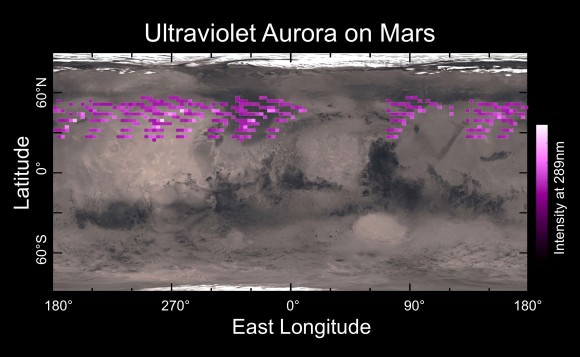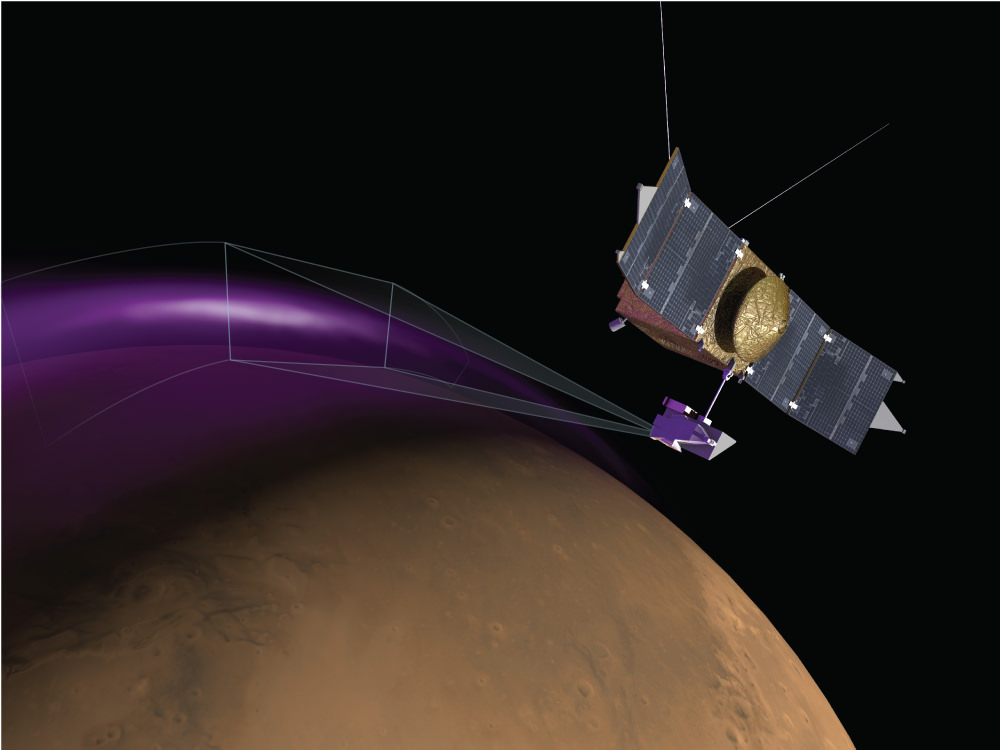Just a day after skywatchers at mid- to upper-latitudes around the world were treated to a particularly energetic display of auroras on the night of March 17 as a result of an intense geomagnetic storm, researchers announced findings from NASA’s MAVEN mission of auroral action observed on Mars – although in energetic ultraviolet wavelengths rather than visible light.
Detected by MAVEN’s Imaging Ultraviolet Spectrograph (IUVS) instrument over five days before Dec. 25, 2014, the ultraviolet auroras have been nicknamed Mars’ “Christmas lights.” They were observed across the planet’s mid-northern latitudes and are the result of Mars’ atmosphere interacting directly with the solar wind.

While auroras on Earth typically occur at altitudes of 80 to 300 kilometers (50 to 200 miles) and occasionally even higher, Mars’ atmospheric displays were found to be much lower, indicating higher levels of energy.
“What’s especially surprising about the aurora we saw is how deep in the atmosphere it occurs – much deeper than at Earth or elsewhere on Mars,” said Arnaud Stiepen, IUVS team member at the University of Colorado. “The electrons producing it must be really energetic.”
To a human observer on Mars the light show probably wouldn’t be very dramatic, though. Without abundant amounts of oxygen and nitrogen in its thin atmosphere a Martian aurora would be a dim blue glow at best, if not out of the visible spectrum entirely.
This isn’t the first time auroras have been spotted on Mars; observations with ESA’s Mars Express in 2004 were actually the first detections of the phenomenon on the Red Planet. Made with the spacecraft’s SPICAM ultraviolet spectrometer, the observations showed that Mars’ auroras are unlike those found anywhere else in the Solar System in that they are generated by particle interactions with very localized magnetic field emissions, rather than a globally-generated one (like Earth’s).
(So no, it’s not a total surprise… but it’s still very cool!)
In addition to auroras MAVEN also detected diffuse but widespread dust clouds located surprisingly high in the Martian atmosphere. It’s not yet understood what process is delivering dust so high – 150-300 kilometers up (93-186 miles) – or if it is a permanent or temporary feature.
Read more in the MAVEN news release here.
Source: NASA and Nature


Is the solar wind significantly weaker at Mars ? Why don’t the auroras appear in the visible spectrum (even if the interaction is with the atmosphere and not with a magnetic field ?)
Molecular and atomic oxygen and molecular nitrogen are not found in enough concentrations in Mars’ atmosphere to create visible-light auroras like they do on Earth.
I’m not sure why the lower altitude of the auroras on Mars should necessarily be indicative of higher energies?
Mars’ atmosphere is ~100 times less dense than Earth’s, which means that on Mars there’s a lot less material available to fluoresce. More to the point, gravity will cause that material to concentrate much more closely to the ground than is found on Earth. If one were to observe Barsoomian auroras at all, I would think one should expect them to be found closer to the surface than those observed here on Terra. In short, the ultraviolet emissions peak seems far more indicative of the energies involved than the observed altitude.
I’m MUCH more interested in the mechanism(s?) which is(are?) creating/maintaining those dust clouds at such an amazingly high altitude. Even on Earth, those things are high enough to be in low orbit; without doing more math than my brain can handle this early in the morning it seems like they’re approaching the atmospheric equivalent of a GPS-level orbit on Mars. Maybe the ancient remains of a former asteroid-moon which (like Phobos will eventually) got too close to the planet and fragmented?
I really like the mag. field statement “…Mars’ auroras are unlike those found anywhere else in the Solar System in that they are generated by particle interactions with very localized magnetic field emissions…”
And those very localized magnetic field emissions are generated by what? Since the image resolution is so low it’s hard to imagine. How about ionized ice-dust clouds in Mars’ upper atmosphere during summer months – lofted by tribo electrically enhanced dust devils?
Was this study limited to Mars’ northern hemisphere due to orbital dynamics? Where are the southern aurora’s?
They are generated by remnant magnetism that exists in certain crustal minerals, like magnetite and hematites, even long after Mars no longer has a core-generated magnetosphere.